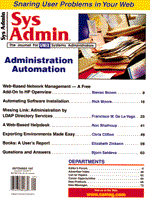
Editor's Forum
Quite often we tend to think of SA automation, the theme of this issue, as the process of writing shell, Perl, and other scripts that perform various system administration tasks without our direct intervention. Additionally, our view of system administration is all too often server-centric. We often pay less attention than we should to our users' desktops, the clients for both our servers and our administrative services. However, several important forces are developing within the industry that will have significant impact on how we go about automating system administration tasks, particularly with respect to our users' desktops. Consider, for example, the interplay between the current brouhahas over network computers (NCs), NetPCs (the Intel and Microsoft alternative to NC thin clients), Java, and Windows NT. The NC and Java have been touted as cost-effective alternatives to the current fat-client, PC-based desktop. While the NC is technologically little more than an upgraded, compact X terminal, it offers greater flexibility to the user than conventional X terminals. Combined with Java and HTML, the NC provides an inexpensive, centrally manageable platform for users to run applications from a variety of server platforms including Windows NT, UNIX, and legacy mainframes. Although centralized management is the key to reducing the cost of administering the desktop, satisfying users' demands for their favorite applications may ultimately be the deciding factor in the success of the NC. To complicate matters, Microsoft and Intel defined specifications for the NetPC as a means of controlling the cost of desktop administration and to divert attention from the NC. While thinner than current PC desktops, the NetPC is still based on advanced Intel processors and the predominant use of current applications written for Windows environments. The primary difference with the NetPC is the absence of end-user customizations, thereby allowing more cost-effective, centralized administration. The Microsoft/Intel side of the equation is further complicated by several strategies of those companies. On one hand, Microsoft is encouraging developers to write Java code to the Microsoft APIs and extensions, thereby stealing Sun's thunder. On the other hand, Intel has introduced the Pentium II and continues to work on their 64-bit CPU with help from HP, both chips being best suited for a fat-client architecture. But, on the third hand (yes, these monsters always have more than two arms), Microsoft is busy convincing business leaders that scalability means up to eight-way SMP and two-node clusters. Meanwhile, on a fourth hand is the issue of pricing for Windows NT and enterprise-level applications that run on it. Indications are that Microsoft will be at least doubling the price of Windows NT Enterprise Edition and many enterprise-level application vendors are already charging the same price for their Windows NT and UNIX versions. What all of this means for system administration and the ability to automate some aspects of it will likely be clarified over the next couple of years. I suspect, however, that you will see a mix of all of these desktop alternatives, with a growing emphasis at the application level for platform independence (i.e., more Java-based applications running in a browser environment). Meanwhile, the fat-client may replace the corner office as the status symbol for the twenty-first century. The real bottom line, however, is that you can continue to encourage your sons and daughters to take up system administration as a career. The complexity of the task and the career opportunities provided by that complexity are not likely to go away.
Sincerely yours,
|